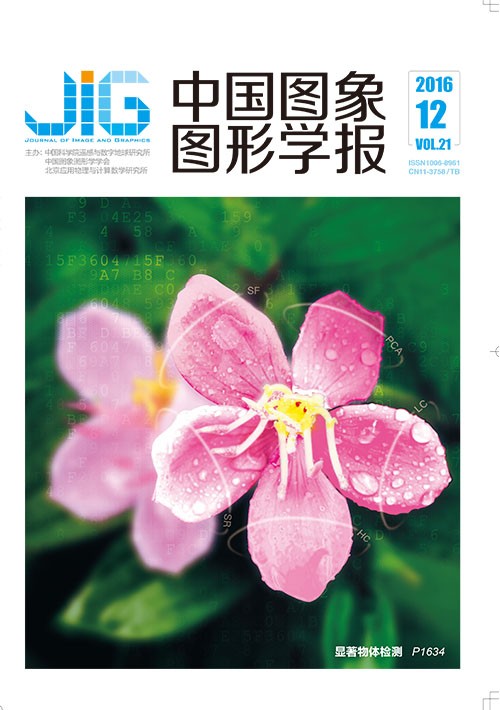
分数阶微分的婴幼儿脑MR图像增强算法
摘 要
目的 由于传统的分数阶微分算法本质是提高相邻像素点的灰度差,达到增强对比度的作用,但是同时会放大和产生噪声,这容易使婴幼儿脑MR图像的增强效果有限或过增强。为了解决上述问题,提出一种融合非局部均值信息的自适应分数阶微分的婴幼儿脑MR图像增强算法。方法 用平均梯度和大津算法自适应确定分数阶阶数,融合纹理粗糙度确定初始的分数阶阶数。为了进一步抵制噪声等干扰,利用更大邻域的纹理信息,融入非局部思想确定分数阶微分的阶数。最后用最终的分数阶阶数对图像进行滤波,得到最终的增强图像。结果 实验通过信息熵、平均梯度和空间频率指标统计结果证明本文算法具有优越的图像增强性能。信息熵指标能够高出对比算法0.2%~12%,平均梯度指标能够高出对比算法5%~59%,空间频率指标能够高出对比算法6%~59%。结论 本文算法可以在增强纹理细节及抑制分数阶微分引入噪声方面都取得较好的效果。本文算法也适用于普通的模糊图像,具有良好的应用背景。
关键词
Improved fractional differential algorithm for infant brain MR image enhancement
Yang Na1, Feng Yun1, Wei Ying1,2(1.College of Information Science and Engineering, Northeastern University, Shenyang 110004, China;2.Key Laboratory of Medical Imaging Calculation of the Ministry of Education, Shenyang 110004, China) Abstract
Objective Given the fuzziness and unevenness of infant brain images, infant brain MR image enhancement has become an important topic. Traditional fractional differential algorithm is used essentially to expand the difference between adjacent gray pixels. The order of traditional fractional differential fluctuates strongly in the area of intense gray change, thereby leading to image over-enhancement and introduction of noise. This condition is likely to cause the infant brain MR image enhancement effect to be limited and over-enhanced. To solve the aforementioned problems, we propose an adaptive fractional differential MR image enhancement algorithm based on non-local means value. Method Otsu algorithm and texture roughness are used to determine the initial number of fractional order. The pixel gray value of the Otsu algorithm is replaced with the average gradient matrix, and the image is divided into two parts by threshold (t) determined by Otsu algorithm and gradient matrix, texture section, and edge section. Roughness is the physical quantity that describes the size and distribution of the particle. The larger the size of the base elements and the farther the distance between them, the rougher is the texture. In the smooth region of the image, roughness is smaller, and roughness is relatively larger in rich texture regions. To suppress noise interference, a larger range of texture information is integrated into the non-local means, which is used to determine the final number of fractional order. The order of the current search block is determined by initial order matrix. The non-local means is used to filter the order matrix of the searching area. The weight contribution of the neighborhood block to the central block is determined by the similarity of their order matrix. If their structures are similar, the weight is large. Otherwise, the weight is small. This condition can effectively reduce the number of mutations caused by noise, edge, and other factors, thereby effectively retaining the image details after filtering. Finally, the fractional-order filter original image is used and the final enhanced image is obtained. Result In this paper, the information entropy, average gradient, and spatial frequency are obtained as statistical indexes. Experimental results prove that this algorithm has superior performance in image enhancement. Information entropy is higher by 0.2% to 12% than that of compared algorithms. Average gradient is higher by 5% to 59% than that of compared algorithms. Spatial frequency is higher by 6% to 59% than that of compared algorithms. Only the information entropy is slightly lower than the fractional-order differential and wavelet decomposition of the image enhancement algorithm, and the average gradient and spatial frequency is slightly lower than that of the adaptive fractional-order differential algorithm. Conclusion The algorithm we propose is more capable of enhancing texture details and is effective in suppressing new noise than the compared algorithms in this paper. The algorithm is also applicable to general fuzzy images and has good application potential.
Keywords
|



 中国图象图形学报 │ 京ICP备05080539号-4 │ 本系统由
中国图象图形学报 │ 京ICP备05080539号-4 │ 本系统由